Architecture and sculpture of ancient Greece
POLYCLET
At the same time, it does not follow from this that artistic life was concentrated by the beginning of the second half of the century only in Athens. Thus, information about the works of the masters of Asia Minor Greece was preserved, the art of the Greek cities of Sicily continued to flourish and southern Italy... The sculpture of the Peloponnese was of the greatest importance, in particular the old center of the development of Dorian sculpture - Argos.
It was from Argos that a contemporary of Phidias Polycletus, one of the great masters of the Greek classics, who worked in the middle and in the third quarter of the 5th century, emerged. BC.
The art of Polykleitos is associated with the traditions of the Argos-Sikion school, with its primary interest in depicting a calmly standing figure. In his statue ʼʼDorifor (The spear-bearerʼʼ), executed around the middle of the 5th century. BC, Polycletus created the image of a young warrior who embodied the ideal of a valiant citizen.
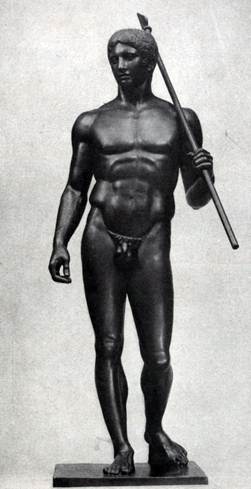
180. Polyclet. Dorifor.
Posted on ref.rf
About 440 ᴦ. BC NS. Roman marble copy after a lost bronze original. Naples. National Museum... Photo taken from a bronze cast in the Museum of Fine Arts. A.S. Pushkin (Moscow).
It was believed that the figure was created on the basis of the provisions of Pythagoreanism, in this regard, in ancient times, the statue of Dorifor was often called the "canon of Polycletus", especially since his unpreserved treatise on aesthetics was called "Canon". Here, the basis of the rhythmic composition is the principle of cross unevenness of body movement (the right side, that is, the supporting leg and the arm lowered along the body, are static and tense, the left, that is, the leg and arm with the spear remaining behind, are relaxed, but in motion). The forms of this statue are repeated in most of the works of the sculptor and his school.
The distance from the chin to the crown of the head in the statues of Polycletus is equal to one seventh of the body height, the distance from the eyes to the chin is one sixteenth, the height of the face is one tenth.
In his "Canon", Polycletus paid great attention to the Pythagorean theory of gold division (the entire length refers to the greater part as much as to the smaller one). For example, the entire height of "Dorifor" refers to the distance from the floor to the navel, as this last distance refers to the distance from the navel to the crown. At the same time, Polycletus rejected the gold division if it contradicted the natural parameters of the human body.
The treatise also embodies theoretical ideas about the crossed distribution of tension in the arms and legs. "Dorifor" is an early example of a classic counterpost (from Italian. contrapposto- the opposite), reception of an image in which the position of one part of the body is contrasted with the position of the other part. Sometimes this statue was also called the "Canon of Polycletus", it was even assumed that Polycletus executed the statue so that others would use it as a model.
Towards the end of his life, Polycletus departed from strict adherence to his "Canon", becoming close to the masters of Attica. His "Diadumen" - a young man who crowns himself with a victorious band, is a statue created around 420 ᴦ. BC, clearly differs from "Dorifor" in more graceful and slender proportions, light movement and greater spirituality of the image. 181 6. Polyclet. Diadumen. About 420 ᴦ. BC NS. Roman marble copy after a lost bronze original. Athens. National Museum.
Cities the ancient world usually appeared near high cliff, a citadel was erected on it, so that there was a place to hide if the enemy penetrated the city. Such a citadel was called acropolis.
Likewise, on the rock, which towered almost 150 meters above Athens and has long served as a natural defensive structure, the upper city gradually formed in the form of a fortress (acropolis) with various defensive, public and religious structures.
Acropolis of Athens began to build up in the II millennium BC. During the Greco-Persian wars (480-479 BC), it was completely destroyed, later, under the leadership of the sculptor and architect Phidias, its restoration and reconstruction began.
The Acropolis is one of those places, about which everyone insists that they are magnificent, unique. But don't ask why. Nobody can answer you ... ʼʼ. It can be measured, even all its stones can be counted. It's not that hard to walk it from end to end - it will only take a few minutes.
The walls of the Acropolis are steep and steep. Four great creations still stand on this rocky hill. A wide zigzag road runs from the base of the hill to the only entrance.
it Propylaea- a monumental gate with Doric columns and a wide staircase. They were built by the architect Mnesicles in 437-432 BC.
But before entering these majestic marble gates, everyone involuntarily turned to the right. There, on a high pedestal of the bastion that once guarded the entrance to the acropolis, stands the temple of the goddess of victory Nicky Apteros, decorated with Ionic columns.
This is the work of the architect Callicrates (second half of the 5th century BC). The temple - light, airy, unusually beautiful - stood out for its whiteness against the blue background of the sky. This fragile building, like an elegant marble toy, seems to be smiling on its own and makes passers-by smile affectionately.
The restless, passionate and active gods of Greece were like the Greeks themselves. True, they were taller, knew how to fly through the air, take any form, turn into animals and plants. But in all other respects they behaved like ordinary people: they got married, deceived each other, quarreled, made peace, punished children ...
The goddess of victory, Nika, was portrayed as a beautiful woman with large wings: victory is fickle and flies from one opponent to another.
The Athenians portrayed her wingless, so that she would not leave the city, which so recently won a great victory over the Persians. Deprived of her wings, the goddess could no longer fly and had to stay in Athens forever.
Nika's temple stands on a rock ledge. It is slightly turned towards the Propylaea and plays the role of a beacon for the processions that go around the rock.
Immediately beyond the Propylaea stood proudly Athena the Warrior, the spear of which greeted a traveler from afar and served as a beacon for navigators. The inscription on the stone pedestal read: "The Athenians dedicated from the victory over the Persians". This meant that the statue was cast from bronze weapons taken from the Persians as a result of their victories.
There was also a temple ensemble on the Acropolis Erechtheion, which (according to the plan of its creators) was to link together several sanctuaries located at different levels - the rock here is very uneven.
The northern portico of the Erechtheion led to the sanctuary of Athena, where a wooden statue of the goddess was kept, allegedly falling from the sky. The door from the sanctuary opened into a small courtyard where the only sacred olive tree in the entire Acropolis grew ĸᴏᴛᴏᴩᴏᴇ rose when Athena touched this place to the rock with your sword.
Through the eastern portico one could get into the sanctuary of Poseidon, where he, striking the rock with his trident, left three furrows with murmuring water. There was also the sanctuary of Erechtheus, revered on a par with Pose-Eidon.
central part the temple is a rectangular room (24.1x13.1 meters). The temple also housed the tomb and sanctuary of the first legendary king of Attica Kekrop.
On the south side of the Erechtheion is the illustrious portico caryatids: At the edge of the wall, six girls carved out of marble support the ceiling. Some scholars suggest that the portico served as a tribune for respectable citizens or that priests gathered here for religious ceremonies. But the exact purpose of the portico is still unclear, because "portico" means the threshold, and in this case the portico did not have doors and it is impossible to get inside the temple from here.
Figures of the portico of the caryatids - ϶ᴛᴏ in fact, supports that replace a pillar or column, they also perfectly convey the lightness and flexibility of girlish figures.
Posted on ref.rf
The Turks, who at one time captured Athens and did not allow images of a person due to their Muslim beliefs, however, did not destroy these statues. Οʜᴎ confined themselves to cutting off the faces of the girls.
In 1803, Lord Elgin, the English ambassador to Constantinople and a collector, using the permission of the Turkish Sultan, broke one of the Caryatids in the temple and took it to England, where he offered it to the British Museum.
Explaining too broadly the firman of the Turkish sultan, he also took with him many of Phidias' sculptures and sold them for 35,000 pounds sterling. Firman said that “no one should prevent him from taking away several stones with inscriptions or figures from the Acropolis”.
Eljin filled 201 boxes with such "stones". As he himself stated, he took only those sculptures that had already fallen or were in danger of falling, ostensibly in order to save them from final destruction. But Byron also called him a thief.
Later (during the restoration of the portico of the Caryatids in 1845-1847), the British Museum sent to Athens a plaster cast of the statue taken away by Lord Elgin. Subsequently, the cast was replaced with a more durable artificial stone copy made in England.
At the end of the last century, the Greek government demanded that England return the treasures belonging to it, but received an answer that the London climate was more favorable for them.
At the beginning of our millennium, when Greece fell to Byzantium during the partition of the Roman Empire, the Erechtheion was turned into a Christian temple.
Later, the crusaders, who took possession of Athens, made the temple a ducal palace, and during the Turkish conquest of Athens in 1458 in the Erechtheion they set up the harem of the commandant of the fortress.
During the liberation war of 1821-1827, the Greeks and Turks took turns besieging the Acropolis, bombarding its buildings, incl. and the Erechtheion.
In 1830 (after the proclamation of the independence of Greece) on the site of the Erechtheion, only foundations could be found, as well as architectural decorations lying on the ground. Funds for the restoration of this temple ensemble (as well as for the restoration of many other structures of the Acropolis) were given by Heinrich Schliemann.
His closest associate W. Derpfeld carefully measured and compared the antique fragments; by the end of the 70s of the last century, he was already planning to restore the Erechtheion. But this reconstruction was severely criticized, and the temple was dismantled. The building was rebuilt anew under the leadership of the famous Greek scientist P. Kavadias in 1906 and finally restored in 1922.
Parthenon- the temple of the goddess Athena - the most large structure on the Acropolis and the most beautiful creation Greek architecture... It stands not in the center of the square, but somewhat to the side, so that you can immediately grasp the front and side facades, understand the beauty of the temple as a whole.
The ancient Greeks believed that the temple with the main cult statue in the center was like the house of the deity. The Parthenon is the temple of Athena the Virgin (Parthenos), and therefore in its center there was a chrysoelephantine (made of ivory and gold plates on a wooden base) statue of the goddess.
The Parthenon was erected in 447-432 BC. architects Iktin and Kallikrates from Pentelian marble. It was located on a four-level terrace, the size of its base is 69.5x30.9 meters.
On four sides, the Parthenon is surrounded by slender colonnades; between their white marble trunks, gaps of the blue sky are visible. All permeated with light, it seems airy and light.
There are no bright drawings on the white columns, as is found in Egyptian temples... Only longitudinal grooves (flutes) cover them from top to bottom, which makes the temple seem taller and even slimmer.
The columns owe their slenderness and lightness to the fact that they taper slightly upward. In the middle part of the trunk, not at all noticeable to the eyes, they thicken and seem from this elastic, more firmly withstanding the weight of stone blocks. Iktip and Kallikrates, having thought over every smallest detail, created a building that amazes with amazing proportionality, utmost simplicity and purity of all lines.
Placed on the upper platform of the Acropolis, at an altitude of about 150 meters above sea level, the Parthenon was visible not only from anywhere in the city, but also from numerous ships sailing to Athens. The temple was a Doric perimeter surrounded by a columnar 46 columns.
The most famous masters took part in the sculptural decoration of the Parthenon. The artistic director of the construction and design of the Parthenon was Phidias, one of the greatest sculptors of all time. He owns the overall composition and development of the entire sculptural decoration, part of which he made himself. The organizational side of the construction was handled by Pericles, the largest statesman of Athens.
All the sculptural decoration of the Parthenon was intended to glorify the goddess Athena and her city - Athens.
The theme of the eastern pediment is the birth of the beloved daughter of Zeus. On the western pediment, the master depicted a scene of Athena's dispute with Poseeidon for domination over Attica. According to the myth, Athena won the dispute, giving the inhabitants of this country an olive tree.
The gods of Greece gathered on the pediments of the Parthenon: the thunderer Zeus, the mighty ruler of the seas Poseeidon, the wise warrior Athena, the winged Nike.
The sculptural decoration of the Parthenon was completed by a frieze, on which a solemn procession was presented during the feast of the Great Panathenes. This frieze is considered one of the pinnacles of classical art. For all its compositional unity, it amazed with its diversity.
Of more than 500 figures of young men, elders, girls, foot and horse, none of them repeated the other, the movements of people and animals were conveyed with amazing dynamism
The figures of the sculptural Greek relief are not flat, they have the volume and shape of the human body. They differ from statues only in that they are not processed from all sides, but, as it were, merge with the background formed by the flat surface of the stone.
Light colors enlivened the Parthenon marble. The red background emphasized the whiteness of the figures, the narrow vertical protrusions separating one plate of the frieze from another clearly stood out in blue, the gilding shone brightly. Behind the columns, a festive procession was depicted on a marble band that encircled all four facades of the building. There are almost no gods here, and people, forever imprinted in stone, moved along the two long sides of the building and united on the eastern facade, where a solemn ceremony of presenting the priest with a garment woven by Athenian girls for the goddess took place.
Each figure is characterized by its unique beauty, and together they accurately reflect the true life and customs of the ancient city.
Indeed, once every five years, on one of the hot days of midsummer, a popular celebration took place in Athens in honor of the birth of the goddess Athena. It was called the Great Panathenaea. It was attended not only by the citizens of the Athenian state, but also by many guests. The festival consisted of a solemn procession (pomp), bringing a hecatomb (100 head of cattle) and a general meal, sports, equestrian and musical competitions. The winner received a special, so-called Panathenian amphora filled with oil, and a wreath of leaves of the sacred olive growing on the Acropolis.
The most solemn moment of the holiday was the national procession to the Acropolis. Riders on horseback moved, statesmen, warriors in armor and young athletes walked.
Priests and noble people walked in long white robes, heralds loudly praised the goddess, musicians filled the still cool morning air with joyful sounds. Sacrificial animals climbed the high hill of the Acropolis along the zigzag-shaped Panathenian road, trampled by thousands of people.
Young men and women were carrying a model of the sacred Panathenian ship with a peplos (blanket) attached to its mast. A light breeze fluttered the bright fabric of a yellow-purple robe, ĸᴏᴛᴏᴩᴏᴇ the noble girls of the city carried as a gift to the goddess Athens. For a whole year they weaved and embroidered it. Other girls raised sacred sacrifice vessels high above their heads.
The procession gradually approached the Parthenon. The entrance to the temple was not made from the side of the Propylaea, but on the other, as if in order for everyone to first go around, inspect and appreciate the beauty of all parts of the beautiful building. Unlike Christian churches, the ancient Greek ones were not intended for worship inside them, the people during the cult activities remained outside the temple.
In the depths of the temple, surrounded on three sides by two-tier colonnades, stood proudly famous statue Virgin of Athena, created by the illustrious Phidias. Her robe, helmet, and shield were made of pure, sparkling gold, and her face and hands shone with the white of ivory.
Many book volumes have been written about the Parthenon, among them there are monographs about each of his sculptures and about each step of gradual decline since the time when, after the decree of Theodosius I, it became a Christian temple.
In the 15th century, the Turks made a mosque out of it, and in the 17th century - a powder store. The Turkish-Venetian war of 1687 turned it into final ruins, when an artillery shell hit it and in an instant did what the all-devouring time could not do in 2000 years.
Architecture and sculpture of ancient Greece - concept and types. Classification and features of the category "Architecture and sculpture of ancient Greece" 2014, 2015.
In the 5th-4th centuries BC. the art of Greece has entered the period of its heyday. This period is usually called classical (from the Latin "exemplary" "first-class").
Architecture has reached exceptional perfection. The Greeks attached great importance to the architecture of public buildings - temples, gymnasia, tolos (places of meeting of officials). The most important role is played by the temples, which symbolized the water and heavenly elements. Temples were erected as earthly dwellings of the gods. The roofs of the temples were gable, covered with marble tiles. The edges of the pediments (a triangular ledge formed by a gable roof) had sculptural decorations. The rectangular building of the temple was surrounded by marble columns.
In Greece arose three architectural styles, or orders: Doric, Ionic and Corinthian.
Order is the location of the main architectural parts of the building, among which the columns play the main role.
Doric columns they were distinguished by severity, masculinity, perfection of proportions. The trunks of the columns were cut with vertical grooves.
Ionian columns characterized by lightness and grace, and the capitals (the upper part of the column) were decorated with graceful curls.
The characteristic features of the exquisite Corinthian style splendor and richness of ornaments appeared. The capital was decorated with leaves.
And today, architects make extensive use of the architectural styles of Ancient Greece.
Sculpture developed in close connection with architecture. Statues were used to decorate temples, dwellings of people, and to perpetuate the memory of famous figures. The sculptures were made of limestone, marble, bronze.
The famous sculptor of Ancient Greece was Myron, who was born in Eleuthera (on the border of Boeotia and Attica). "Discobolus" brought him immortal fame. The statue captured the young man at the moment of throwing the disc. The master presented an athletic figure in motion, with the torso tilted forward in all the exertion of physical strength.
Polycletus of Argos was considered the great classic of Greek sculpture. He created the statue of the spear-bearer "Dorifor".
The sculptor determined the proportions of the human body: the length of the foot should have been 1/6 of the body's length, the height of the head - 1/7. These relationships were strictly observed in the figure of "Dorifor", who embodied the ideal of male beauty.
An outstanding sculptor and architect was the Athenian master Phidias. He created the decorations of the Athenian Acropolis, the famous statues of Athena. The 12-meter statue of the Parthenon - Athena-Virgin (Parthenos) was made of gold and ivory. Athena stood leaning on a spear, and in her right hand she was holding a statue of Victory (Niki).
The hallmarks of Greek sculpture of this period were grandeur, tranquility and solemnity.
In the first half of the VI century. BC. in Attica, a black-figure style of painting was developed - the image of black-glazed figures on a light background of a vase. The paintings on the vase were compositions from the lives of gods and heroes, as well as scenes from the modern life of the Greeks.
In the 30s of the VI century. BC. the black-figure style was replaced by the red-figure style. Instead of black figures on a light background, they began to depict light figures on a dark background. The subtlety and sophistication of the drawing of the red-figure painting manifested itself in the fragment "Penelope and Telemachus".
Ancient writers report that the first famous Greek painter in Athens was Polygnotus of Tasas. Together with his students, he painted the Pinakothek - a repository of paintings.
Polygnot created frescoes - painting on wet plaster, painted on wooden discs covered with white gypsum mortar. He used white, black, red and yellow for paints. The works of Greek architecture and sculpture have come down to us only partially - in fragments.
The cities of the ancient world usually appeared near a high rock, on which a citadel was erected, so that there was a place to hide if the enemy penetrated into the city. Such a citadel was called the acropolis. Likewise, on the rock, which towered almost 150 meters above Athens and has long served as a natural defensive structure, the upper city gradually formed in the form of a fortress (acropolis) with various defensive, public and religious structures. The Athenian Acropolis began to build up in the II millennium BC. During the Greco-Persian wars (480-479 BC), it was completely destroyed, later, under the leadership of the sculptor and architect Phidias, its restoration and reconstruction began.
The Acropolis is one of those places “about which everyone says that they are magnificent, unique. But don't ask why. Nobody can answer you ... ". It can be measured, even all its stones can be counted. It's not that hard to walk it from end to end - it only takes a few minutes. The walls of the Acropolis are steep and steep. Four great creations still stand on this rocky hill. A wide zigzag road runs from the base of the hill to the only entrance. This is the Propylaea, a monumental gateway with Doric columns and a wide staircase. They were built by the architect Mnesicles in 437-432 BC. But before entering these majestic marble gates, everyone involuntarily turned to the right. There, on a high pedestal of the bastion that once guarded the entrance to the acropolis, stands the temple of the goddess of victory Nike Apteros, decorated with Ionic columns. This is the work of the architect Callicrates (second half of the 5th century BC). The temple - light, airy, unusually beautiful - stood out for its whiteness against the blue background of the sky. This fragile building, like an elegant marble toy, seems to be smiling on its own and makes passers-by smile affectionately. The restless, ardent and active gods of Greece were like the Greeks themselves. True, they were taller, knew how to fly through the air, take any form, turn into animals and plants. But in all other respects they behaved like ordinary people: they got married, deceived each other, quarreled, made peace, punished children ...
The goddess of victory, Nika, was portrayed as a beautiful woman with large wings: victory is fickle and flies from one opponent to another. The Athenians portrayed her wingless, so that she would not leave the city, which so recently won a great victory over the Persians. Deprived of her wings, the goddess could no longer fly and had to stay in Athens forever. Nika's temple stands on a rock ledge. It is slightly turned towards the Propylaea and plays the role of a beacon for the processions that go around the rock. Immediately beyond the Propylaea, Athena the Warrior proudly towered, whose spear greeted a traveler from afar and served as a beacon for sailors. The inscription on the stone pedestal read: "The Athenians dedicated from the victory over the Persians." This meant that the statue was cast from bronze weapons taken from the Persians as a result of their victories.
On the Acropolis there was also the Erechtheion temple ensemble, which (according to the plan of its creators) was supposed to link together several sanctuaries located at different levels - the rock here is very uneven. The northern portico of the Erechtheion led to the sanctuary of Athena, where a wooden statue of the goddess was kept, allegedly falling from the sky. The door from the sanctuary opened into a small courtyard, where the only sacred olive tree in the entire Acropolis grew, which rose when Athena touched the rock in this place with her sword. Through the eastern portico one could get to the sanctuary of Poseidon, where he, striking the rock with his trident, left three furrows with murmuring water. There was also the sanctuary of Erechtheus, revered on a par with Poseidon.
The central part of the temple is a rectangular room (24.1x13.1 meters). The temple also housed the tomb and sanctuary of the first legendary king of Attica Kekrop. On the south side of the Erechtheion is the famous portico of the Caryatids: at the edge of the wall, six maidens carved out of marble support the ceiling. Some scholars suggest that the portico served as a tribune for respectable citizens or that priests gathered here for religious ceremonies. But the exact purpose of the portico is still unclear, because "portico" means the threshold, and in this case the portico had no doors and from here it is impossible to get inside the temple. Figures of the portico of the caryatids are essentially supports that replace a pillar or column, they also perfectly convey the lightness and flexibility of girlish figures. The Turks, who at one time captured Athens and did not allow images of a person due to their Muslim beliefs, however, did not destroy these statues. They confined themselves to cutting the faces of the girls. In 1803, Lord Elgin, the English ambassador to Constantinople and a collector, using the permission of the Turkish Sultan, broke one of the Caryatids in the temple and took it to England, where he offered it to the British Museum. Explaining too broadly the firman of the Turkish sultan, he also took with him many of Phidias' sculptures and sold them for 35,000 pounds sterling. Firman said that "no one should prevent him from taking away several stones with inscriptions or figures from the Acropolis." Eljin filled 201 boxes with such "stones". As he himself stated, he took only those sculptures that had already fallen or were in danger of falling, ostensibly in order to save them from final destruction. But Byron also called him a thief. Later (during the restoration of the portico of the Caryatids in 1845-1847), the British Museum sent to Athens a plaster cast of the statue taken away by Lord Elgin. Subsequently, the cast was replaced with a more durable artificial stone copy made in England. At the end of the last century, the Greek government demanded that England return the treasures belonging to it, but received an answer that the London climate was more favorable for them.
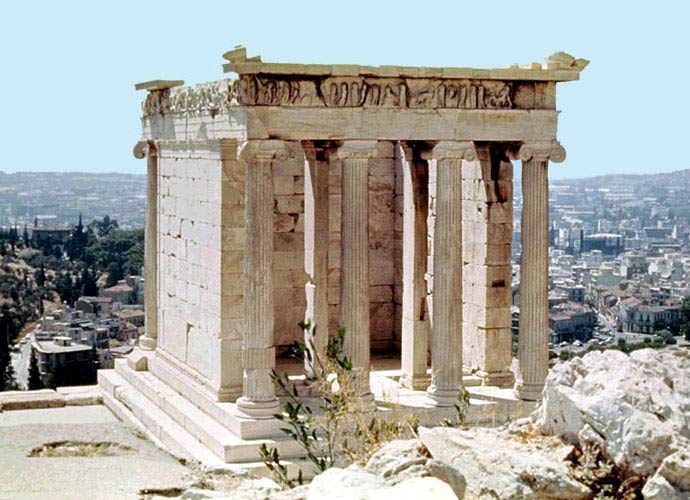
At the beginning of our millennium, when, during the division of the Roman Empire, Greece was ceded to Byzantium, the Erechtheion was turned into a Christian temple. Later, the crusaders, who took possession of Athens, made the temple a ducal palace, and during the Turkish conquest of Athens in 1458 in the Erechtheion they set up the harem of the commandant of the fortress. During the liberation war of 1821-1827, the Iturk Greeks alternately besieged the Acropolis, bombarding its buildings, including the Erechtheion. In 1830 (after the proclamation of the independence of Greece) on the site of the Erechtheion, only foundations could be found, as well as architectural decorations lying on the ground. Funds for the restoration of this temple ensemble (as well as for the restoration of many other structures of the Acropolis) were given by Heinrich Schliemann. His closest associate W. Derpfeld carefully measured and compared the antique fragments; by the end of the 70s of the last century, he was already planning to restore the Erechtheion. But this reconstruction was severely criticized, and the temple was dismantled. The building was rebuilt anew under the leadership of the famous Greek scientist P. Kavadias in 1906 and finally restored in 1922.
The Parthenon, the temple of the goddess Athena, is the largest structure on the Acropolis and the most beautiful creation of Greek architecture. It stands not in the center of the square, but somewhat to the side, so that you can immediately grasp the front and side facades, understand the beauty of the temple as a whole. The ancient Greeks believed that the temple with the main cult statue in the center was like the house of the deity. The Parthenon is the temple of Athena the Virgin (Parthenos), and therefore in its center there was a chrysoelephantine (made of ivory and gold plates on a wooden base) statue of the goddess.
The Parthenon was erected in 447-432 BC. architects Iktin and Kallikrates from Pentelian marble. It was located on a four-level terrace, the size of its base is 69.5x30.9 meters. On four sides, the Parthenon is surrounded by slender colonnades; between their white marble trunks, gaps of the blue sky are visible. All permeated with light, it seems airy and light. There are no bright drawings on the white columns, as is found in Egyptian temples. Only longitudinal grooves (flutes) cover them from top to bottom, which makes the temple seem taller and even slimmer. The columns owe their slenderness and lightness to the fact that they taper slightly upward. In the middle part of the trunk, not at all noticeable to the eyes, they thicken and seem from this elastic, stronger withstanding the weight of stone blocks. Iktin and Kallikrates, having thought through every smallest detail, created a building that amazes with amazing proportionality, utmost simplicity and purity of all lines. Placed on the upper platform of the Acropolis, at an altitude of about 150 meters above sea level, the Parthenon was visible not only from anywhere in the city, but also from numerous ships sailing to Athens. The temple was a Doric perimeter surrounded by a colonnade of 46 columns.
The most famous masters took part in the sculptural decoration of the Parthenon. The artistic director of the construction and decoration of the Parthenon was Phidias, one of the greatest sculptors of all time. He owns the overall composition and development of the entire sculptural decoration, part of which he made himself. The organizational side of the construction was handled by Pericles, the largest statesman of Athens.
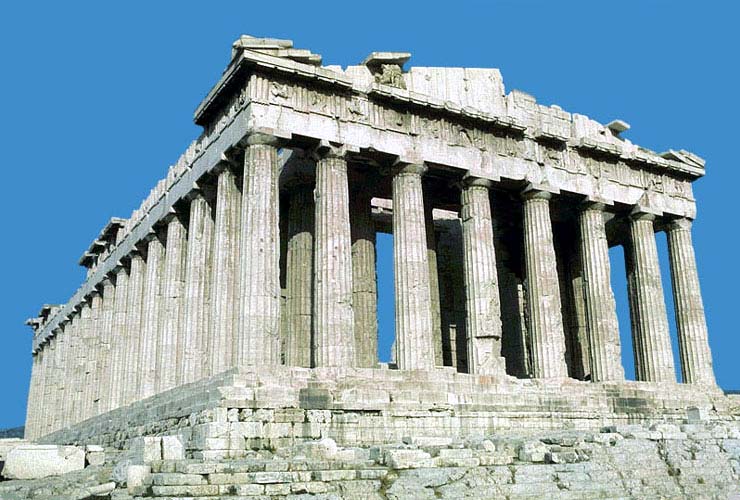
All the sculptural decoration of the Parthenon was intended to glorify the goddess Athena and her city - Athens. The theme of the eastern pediment is the birth of the beloved daughter of Zeus. On the western pediment, the master depicted a scene of the dispute between Athena and Poseidon for domination over Attica. According to the myth, Athena won the dispute, giving the inhabitants of this country an olive tree. The gods of Greece gathered on the pediments of the Parthenon: the thunderer Zeus, the mighty ruler of the seas Poseidon, the wise warrior Athena, the winged Nike. The sculptural decoration of the Parthenon was completed by a frieze, on which a solemn procession was presented during the feast of the Great Panathenaei. This frieze is considered one of the pinnacles of classical art. For all its compositional unity, it amazed with its diversity. Of more than 500 figures of young men, elders, girls, foot and horse, none of them repeated the other, the movements of people and animals were conveyed with amazing dynamism.
Figures of sculptural Greek relief are not flat, they have the volume and shape of the human body. They differ from statues only in that they are not processed from all sides, but, as it were, merge with the background formed by the flat surface of the stone. Light colors enlivened the Parthenon marble. The red background emphasized the whiteness of the figures, the narrow vertical protrusions separating one plate of the frieze from another clearly stood out in blue, the gilding shone brightly. Behind the columns, a festive procession was depicted on a marble band encircling all four facades of the building. There are almost no gods here, and people, forever imprinted in stone, moved along the two long sides of the building and united on the eastern facade, where a solemn ceremony of presenting the priest with a garment woven by Athenian girls for the goddess took place. Each figure is characterized by its unique beauty, and together they accurately reflect the true life and customs of the ancient city.

Indeed, once every five years, on one of the hot days of midsummer, a popular celebration took place in Athens in honor of the birth of the goddess Athena. It was called the Great Panathenae. It was attended not only by the citizens of the Athenian state, but also by many guests. The festival consisted of a solemn procession (pomp), bringing a hecatomb (100 head of cattle) and a general meal, sports, equestrian and musical competitions. The winner received a special, so-called Panathenaic amphora filled with oil, and a wreath of leaves of the sacred olive growing on the Acropolis.
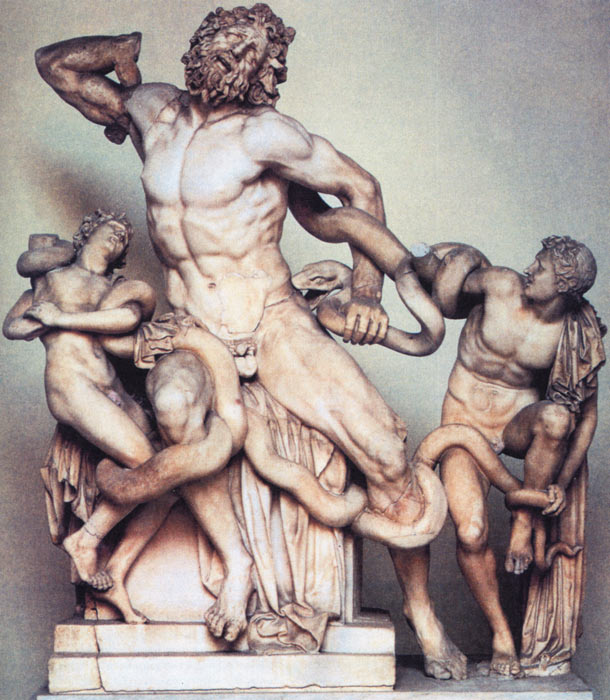
The most solemn moment of the holiday was the nationwide procession to the Acropolis. Riders on horseback moved, statesmen, warriors in armor and young athletes walked. Priests and noble people walked in long white robes, heralds loudly praised the goddess, musicians filled the still cool morning air with joyful sounds. Sacrificial animals climbed the high hill of the Acropolis along the zigzag-shaped Panathenaic road, trampled by thousands of people. Boys and girls were carrying a model of the holy Panathenaan ship with a peplos (blanket) attached to its mast. A light breeze fluttered the bright fabric of a yellow-purple robe, which the noble girls of the city carried as a gift to the goddess Athena. For a whole year they weaved and embroidered it. Other girls raised sacred sacrifice vessels high above their heads. The procession gradually approached the Parthenon. The entrance to the temple was not made from the side of the Propylaea, but on the other, as if so that everyone first walked around, examined and appreciated the beauty of all parts of the beautiful building. Unlike Christian churches, the ancient Greek ones were not intended for worship inside them, the people during the cult activities remained outside the temple. In the depths of the temple, surrounded on three sides by two-tiered colonnades, the famous statue of the Virgin Athena, created by the famous Phidias, proudly stood. Her robe, helmet, and shield were made of pure, glittering gold, and her face and hands shone with ivory white.
Many book volumes have been written about the Parthenon, among them there are monographs about each of his sculptures and about each step of gradual decline since the time when, after the decree of Theodosius I, it became a Christian temple. In the 15th century, the Turks made a mosque out of it, and in the 17th century - a powder store. The Turkish-Venetian war of 1687 turned it into final ruins, when an artillery shell hit it and in an instant did what the all-devouring time could not do in 2000 years.
Architecture and sculpture of ancient Greece
The cities of the ancient world usually appeared near a high rock, on which a citadel was erected, so that there was a place to hide if the enemy penetrated into the city. Such a citadel was called the acropolis. Likewise, on the rock, which towered almost 150 meters above Athens and has long served as a natural defensive structure, the upper city gradually formed in the form of a fortress (acropolis) with various defensive, public and religious structures.
The Athenian Acropolis began to build up in the II millennium BC. During the Greco-Persian wars (480-479 BC), it was completely destroyed, later, under the leadership of the sculptor and architect Phidias, its restoration and reconstruction began.
The Acropolis is one of those places “about which everyone says that they are magnificent, unique. But don't ask why. Nobody can answer you ... ". It can be measured, even all its stones can be counted. It's not that hard to walk it from end to end - it only takes a few minutes. The walls of the Acropolis are steep and steep.
Four great creations still stand on this rocky hill. A wide zigzag road runs from the base of the hill to the only entrance. This is the Propylaea, a monumental gateway with Doric columns and a wide staircase. They were built by the architect Mnesicles in 437-432 BC. But before entering these majestic marble gates, everyone involuntarily turned to the right. There, on a high pedestal of the bastion that once guarded the entrance to the acropolis, stands the temple of the goddess of victory Nike Apteros, decorated with Ionic columns. This is the work of the architect Callicrates (second half of the 5th century BC). The temple - light, airy, unusually beautiful - stood out for its whiteness against the blue sky. This fragile building, like an elegant marble toy, seems to be smiling on its own and makes passers-by smile affectionately.
The restless, ardent and active gods of Greece were like the Greeks themselves. True, they were taller, knew how to fly through the air, take any form, turn into animals and plants. But in all other respects they behaved like ordinary people: they got married, deceived each other, quarreled, made peace, punished children ...
The goddess of victory, Nika, was portrayed as a beautiful woman with large wings: victory is fickle and flies from one opponent to another. The Athenians portrayed her wingless, so that she would not leave the city, which so recently won a great victory over the Persians. Deprived of her wings, the goddess could no longer fly and had to stay in Athens forever.
Nika's temple stands on a rock ledge. It is slightly turned towards the Propylaea and plays the role of a beacon for the processions that go around the rock.
Immediately beyond the Propylaea, Athena the Warrior stood proudly, whose spear greeted a traveler from afar and served as a beacon for sailors. The inscription on the stone pedestal read: "The Athenians dedicated from the victory over the Persians." This meant that the statue was cast from bronze weapons taken from the Persians as a result of their victories. 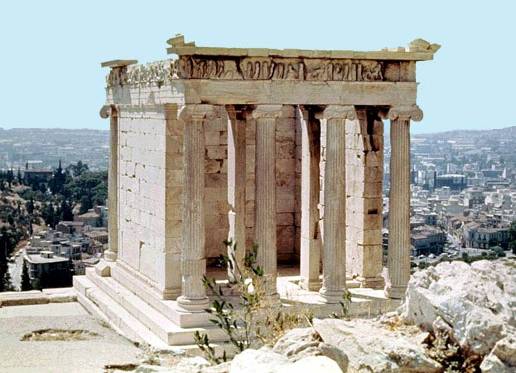
Temple of Niki Apteros,
the architect Callicrates,
449-421 BC Athens 
Temple of Niki Apteros,
the architect Callicrates,
449-421 BC Athens
On the Acropolis there was also the Erechtheion temple ensemble, which (according to the plan of its creators) was supposed to link together several sanctuaries located at different levels - the rock here is very uneven.

Erechtheion,
the builders are unknown,
421-407 BC Athens
The northern portico of the Erechtheion led to the sanctuary of Athena, where a wooden statue of the goddess was kept, allegedly falling from the sky. The door from the sanctuary opened into a small courtyard where the only sacred olive tree in the entire Acropolis grew, which rose when Athena touched the rock in this place with her sword. Through the eastern portico one could get to the sanctuary of Poseidon, where he, striking the rock with his trident, left three furrows with murmuring water. There was also the sanctuary of Erechtheus, revered on a par with Poseidon.
The central part of the temple is a rectangular room (24.1x13.1 meters). The temple also housed the tomb and sanctuary of the first legendary king of Attica Kekrop. On the south side of the Erechtheion is the famous portico of the Caryatids: at the edge of the wall, six maidens carved out of marble support the ceiling. Some scholars suggest that the portico served as a tribune for respectable citizens or that priests gathered here for religious ceremonies. But the exact purpose of the portico is still unclear, because "portico" means the threshold, and in this case the portico had no doors and from here it is impossible to get inside the temple. Figures of the portico of the caryatids are essentially supports that replace a pillar or column, they also perfectly convey the lightness and flexibility of girlish figures. The Turks, who at one time captured Athens and did not allow images of a person due to their Muslim beliefs, however, did not destroy these statues. They confined themselves to cutting the faces of the girls.
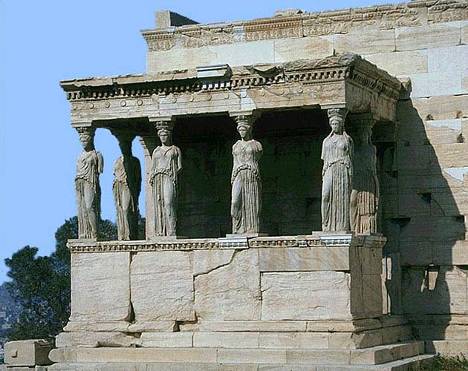
Erechtheion,
the builders are unknown,
421-407 BC Athens
In 1803, Lord Elgin, the English ambassador to Constantinople and a collector, using the permission of the Turkish Sultan, broke one of the Caryatids in the temple and took it to England, where he offered it to the British Museum. Explaining too broadly the firman of the Turkish sultan, he also took with him many of Phidias' sculptures and sold them for 35,000 pounds sterling. Firman said that "no one should prevent him from taking away several stones with inscriptions or figures from the Acropolis." Eljin filled 201 boxes with such "stones". As he himself stated, he took only those sculptures that had already fallen or were in danger of falling, ostensibly in order to save them from final destruction. But Byron also called him a thief. Later (during the restoration of the portico of the Caryatids in 1845-1847), the British Museum sent to Athens a plaster cast of the statue taken away by Lord Elgin. Subsequently, the cast was replaced with a more durable artificial stone copy made in England.
At the end of the last century, the Greek government demanded that England return the treasures belonging to it, but received an answer that the London climate was more favorable for them.
At the beginning of our millennium, when, during the division of the Roman Empire, Greece was ceded to Byzantium, the Erechtheion was turned into a Christian temple. Later, the crusaders, who took possession of Athens, made the temple a ducal palace, and during the Turkish conquest of Athens in 1458 in the Erechtheion they set up the harem of the commandant of the fortress. During the liberation war of 1821-1827, the Greeks and Turks took turns besieging the Acropolis, bombarding its buildings, including the Erechtheion.
In 1830 (after the proclamation of the independence of Greece) on the site of the Erechtheion, only foundations could be found, as well as architectural decorations lying on the ground. Funds for the restoration of this temple ensemble (as well as for the restoration of many other structures of the Acropolis) were given by Heinrich Schliemann. His closest associate W. Derpfeld carefully measured and compared the antique fragments; by the end of the 70s of the last century, he was already planning to restore the Erechtheion. But this reconstruction was severely criticized, and the temple was dismantled. The building was rebuilt anew under the leadership of the famous Greek scientist P. Kavadias in 1906 and finally restored in 1922.
The Parthenon, the temple of the goddess Athena, is the largest structure on the Acropolis and the most beautiful creation of Greek architecture. It stands not in the center of the square, but somewhat to the side, so that you can immediately grasp the front and side facades, understand the beauty of the temple as a whole. The ancient Greeks believed that the temple with the main cult statue in the center was like the house of the deity. The Parthenon is the temple of Athena the Virgin (Parthenos), and therefore in its center there was a chrysoelephantine (made of ivory and gold plates on a wooden base) statue of the goddess.
The Parthenon was erected in 447-432 BC. architects Iktin and Kallikrates from Pentelian marble. It was located on a four-level terrace, the size of its base is 69.5x30.9 meters.
On four sides, the Parthenon is surrounded by slender colonnades; between their white marble trunks, gaps of the blue sky are visible. All permeated with light, it seems airy and light. There are no bright drawings on the white columns, as is found in Egyptian temples. Only longitudinal grooves (flutes) cover them from top to bottom, which makes the temple seem taller and even slimmer. The columns owe their slenderness and lightness to the fact that they taper slightly upward. In the middle part of the trunk, not at all noticeable to the eyes, they thicken and seem from this elastic, stronger withstanding the weight of stone blocks.
Iktip and Kallikrates, having thought over every smallest detail, created a building that amazes with amazing proportionality, utmost simplicity and purity of all lines. Placed on the upper platform of the Acropolis, at an altitude of about 150 meters above sea level, the Parthenon was visible not only from anywhere in the city, but also from numerous ships sailing to Athens. The temple was a Doric perimeter surrounded by a colonnade of 46 columns.
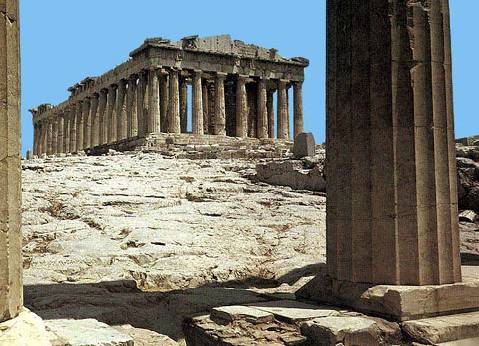
Parthenon,
architects Iktin, Kallikrat,
447-438 BC Athens

Parthenon,
architects Iktin, Kallikrat,
447-438 BC Athens
The most famous masters took part in the sculptural decoration of the Parthenon. The artistic director of the construction and decoration of the Parthenon was Phidias, one of the greatest sculptors of all time. He owns the overall composition and development of the entire sculptural decoration, part of which he made himself. The organizational side of the construction was handled by Pericles, the largest statesman of Athens.
All the sculptural decoration of the Parthenon was intended to glorify the goddess Athena and her city - Athens. The theme of the eastern pediment is the birth of the beloved daughter of Zeus. On the western pediment, the master depicted a scene of the dispute between Athena and Poseidon for domination over Attica. According to the myth, Athena won the dispute, giving the inhabitants of this country an olive tree.
The gods of Greece gathered on the pediments of the Parthenon: the thunderer Zeus, the mighty ruler of the seas Poseidon, the wise warrior Athena, the winged Nike. The sculptural decoration of the Parthenon was completed by a frieze, on which a solemn procession was presented during the feast of the Great Panathenaei. This frieze is considered one of the pinnacles of classical art. For all its compositional unity, it amazed with its diversity. Of more than 500 figures of young men, elders, girls, foot and horse, none of them repeated the other, the movements of people and animals were conveyed with amazing dynamism.
Figures of sculptural Greek relief are not flat, they have the volume and shape of the human body. They differ from statues only in that they are not processed from all sides, but, as it were, merge with the background formed by the flat surface of the stone. Light colors enlivened the Parthenon marble. The red background emphasized the whiteness of the figures, the narrow vertical protrusions separating one plate of the frieze from another clearly stood out in blue, the gilding shone brightly. Behind the columns, a festive procession was depicted on a marble band encircling all four facades of the building. There are almost no gods here, and people, forever imprinted in stone, moved along the two long sides of the building and united on the eastern facade, where a solemn ceremony of presenting the priest with a garment woven by Athenian girls for the goddess took place. Each figure is characterized by its unique beauty, and together they accurately reflect the true life and customs of the ancient city.
Indeed, once every five years, on one of the hot days of midsummer, a popular celebration took place in Athens in honor of the birth of the goddess Athena. It was called the Great Panathenae. It was attended not only by the citizens of the Athenian state, but also by many guests. The festival consisted of a solemn procession (pomp), bringing a hecatomb (100 head of cattle) and a general meal, sports, equestrian and musical competitions. The winner received a special, so-called Panathenaic amphora filled with oil, and a wreath of leaves of the sacred olive growing on the Acropolis.
The most solemn moment of the holiday was the nationwide procession to the Acropolis. Riders on horseback moved, statesmen, warriors in armor and young athletes walked. Priests and noble people walked in long white robes, heralds loudly praised the goddess, musicians filled the still cool morning air with joyful sounds. Sacrificial animals climbed the high hill of the Acropolis along the zigzag-shaped Panathenaic road, trampled by thousands of people. Boys and girls were carrying a model of the holy Panathenaan ship with a peplos (blanket) attached to its mast. A light breeze fluttered the bright fabric of a yellow-purple robe, which the noble girls of the city carried as a gift to the goddess Athena. For a whole year they weaved and embroidered it. Other girls raised sacred sacrifice vessels high above their heads. The procession gradually approached the Parthenon. The entrance to the temple was not made from the side of the Propylaea, but on the other, as if so that everyone first walked around, examined and appreciated the beauty of all parts of the beautiful building. Unlike Christian churches, the ancient Greek ones were not intended for worship inside them, the people during the cult activities remained outside the temple. In the depths of the temple, surrounded on three sides by two-tiered colonnades, the famous statue of the Virgin Athena, created by the famous Phidias, proudly stood. Her robe, helmet, and shield were made of pure, glittering gold, and her face and hands shone with ivory white.
Many book volumes have been written about the Parthenon, among them there are monographs about each of his sculptures and about each step of gradual decline since the time when, after the decree of Theodosius I, it became a Christian temple. In the 15th century, the Turks made a mosque out of it, and in the 17th century - a powder store. The Turkish-Venetian war of 1687 turned it into final ruins, when an artillery shell hit it and in an instant did what the all-devouring time could not do in 2000 years.
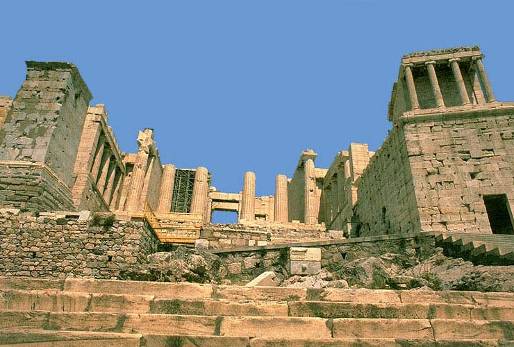
Propylaea,
architect Mnezikl,
437-432 BC Athens

Propylaea,
architect Mnezikl,
437-432 BC Athens 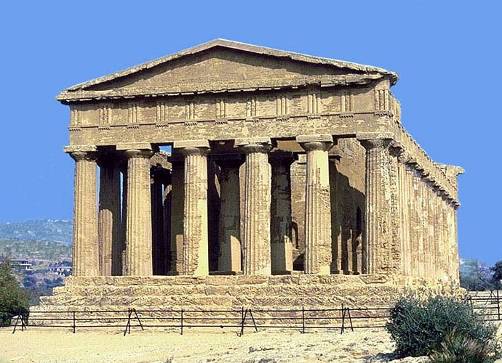
Temple of Demeter,
the builders are unknown,
VI century BC. Olympia
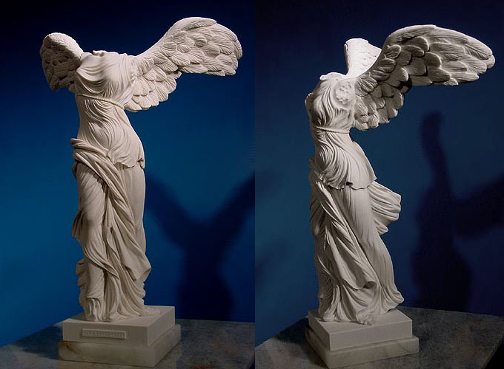
Nika of Samothrace
author unknown,
c. 190 BC
Louvre, Paris 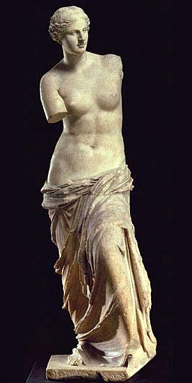
Venus de Milo
Agesander (?),
120 BC
Louvre, Paris 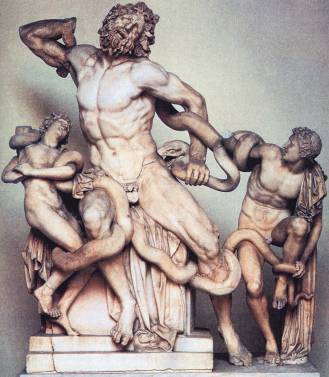
Laocoon
Agesander, Polydorus, Athenodorus, about 40 BC
Greece, Olympia 
Hercules Farnese,
OK. 200 BC NS.,
Nat. Museum
Naples 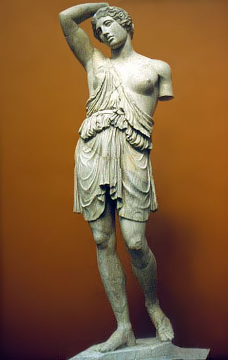
Wounded Amazon
Polycletus, 440 BC
Nat. Museum Rome
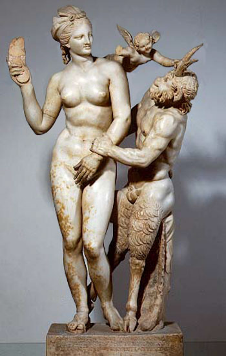
Aphrodite and Pan
100 BC,
Delphi,
Greece
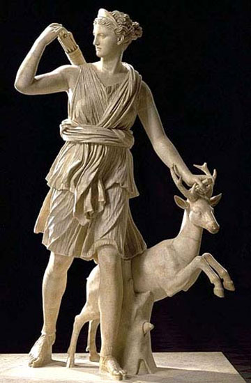
Diana the Huntress
Leochares, about 340 BC,
Louvre, Paris, France
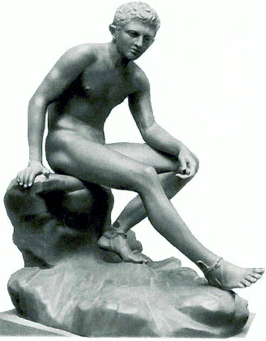
Resting Hermes
Lysippus, IVc. BC NS.,
National Museum, Naples 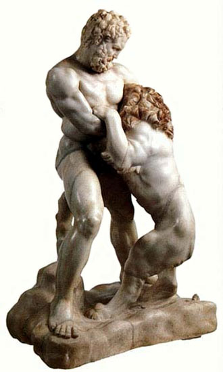
Hercules fighting a lion, Lysippos
OK. 330 BC
Hermitage, Petersburg
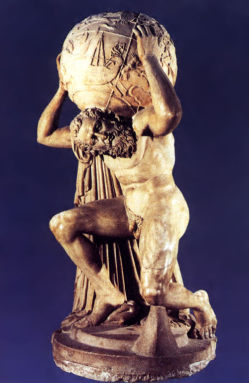
Atlant Farnese
about 200 BC,
Nat. Museum
Naples




